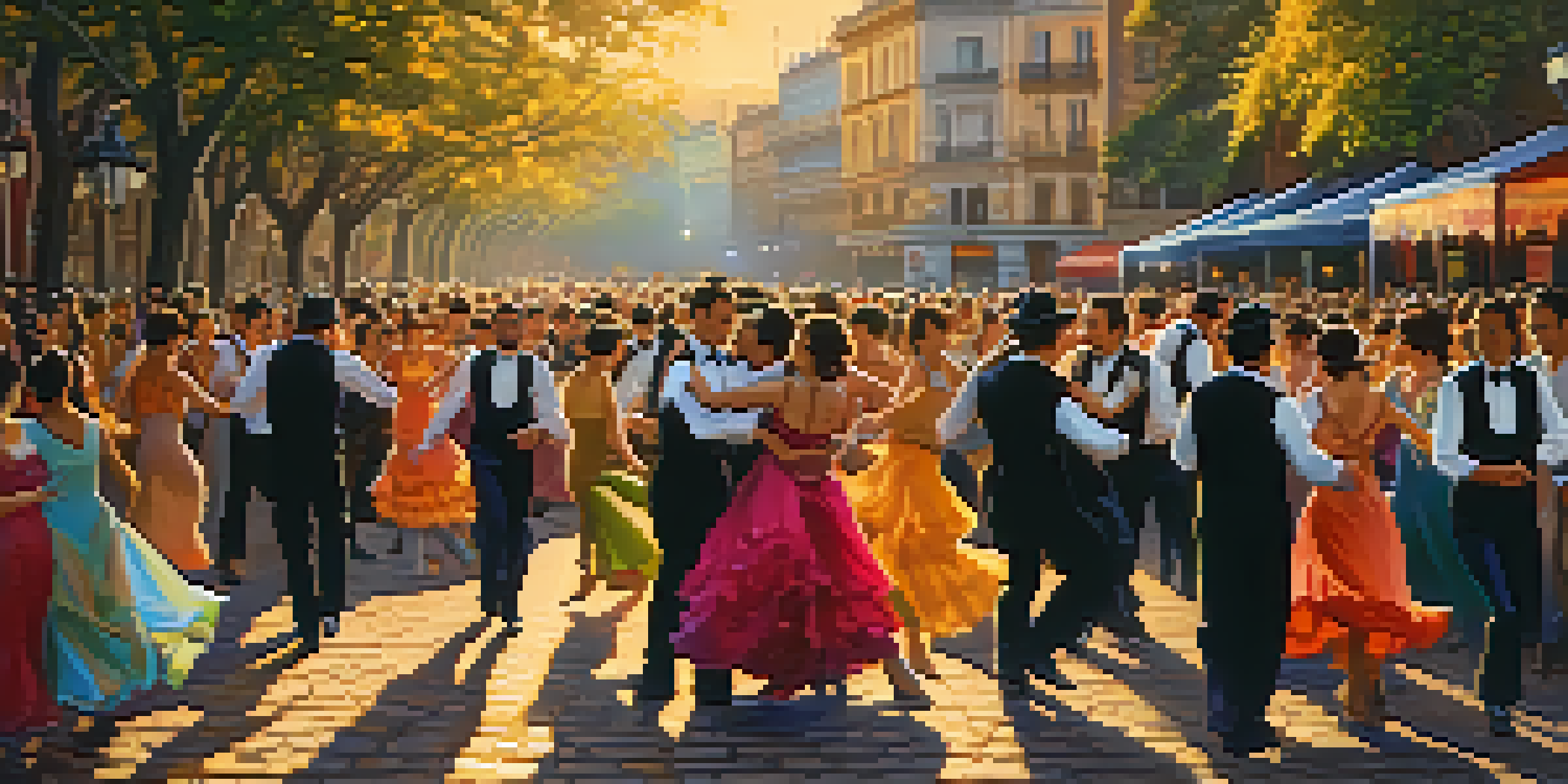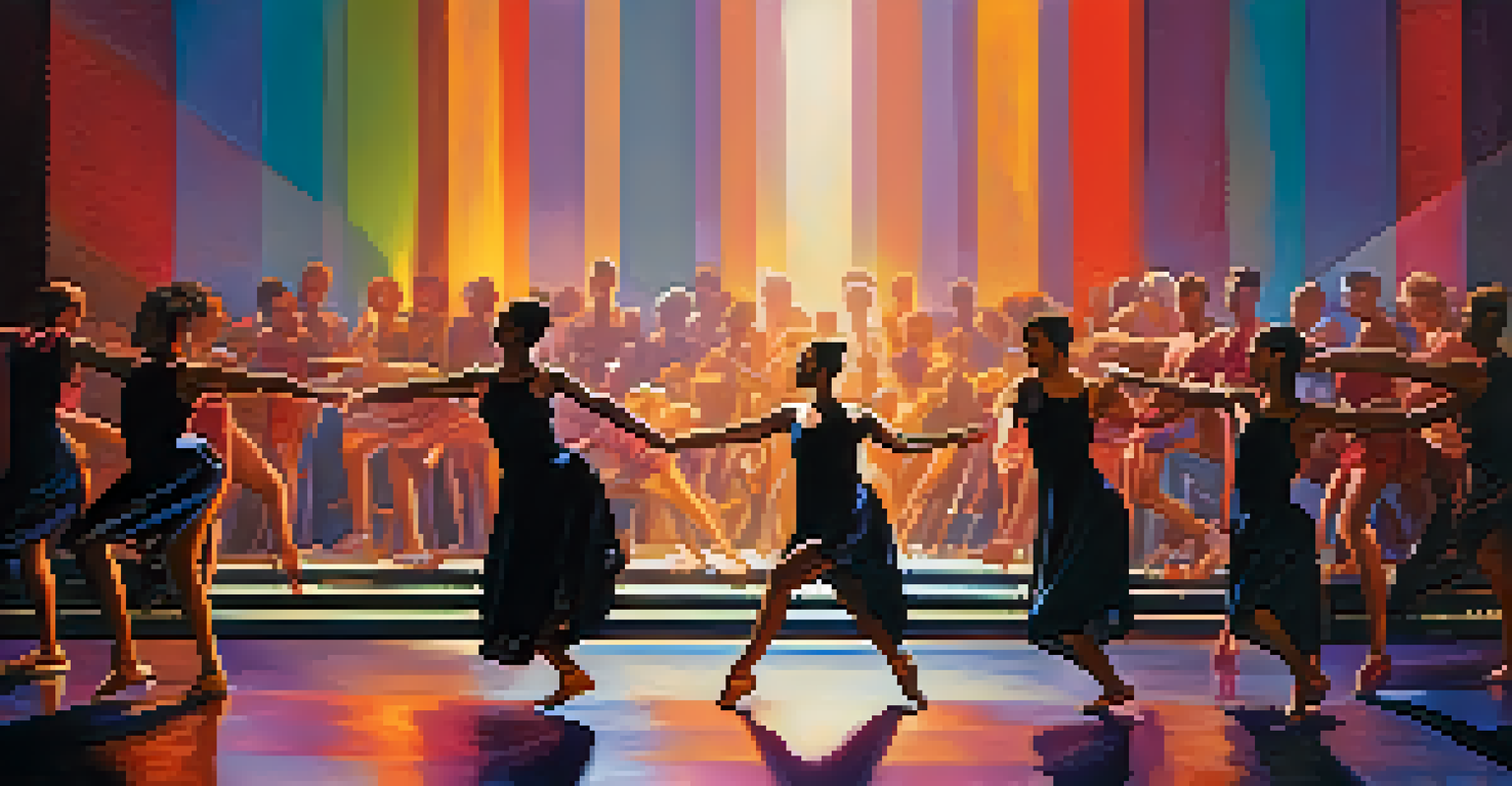Analyzing Dance Tourism: Trends and Future Opportunities

Understanding Dance Tourism: Definition and Scope
Dance tourism refers to travel motivated by a passion for dance, whether it's attending performances, participating in workshops, or enjoying dance festivals. It's a niche market that connects travelers with cultural experiences through dance. As more people seek authentic experiences, dance tourism has gained traction, creating a unique intersection between travel and the arts.
Dance is the hidden language of the soul.
This form of tourism not only enhances cultural appreciation but also boosts local economies. Communities benefit from increased foot traffic, heightened visibility for local artists, and the promotion of regional dance traditions. Dance tourism helps preserve cultural heritage while attracting visitors eager for immersive experiences.
In essence, dance tourism is about more than just watching performances; it's about feeling the rhythm of a place and engaging with its cultural heartbeat. This understanding sets the stage for analyzing current trends and future opportunities in this vibrant sector.
Current Trends in Dance Tourism: What's Hot Right Now?
As we delve into the current landscape of dance tourism, several trends stand out. One notable trend is the rise of immersive dance experiences, where tourists can participate in local dance styles, such as flamenco in Spain or hula in Hawaii. These hands-on experiences not only enrich travelers' understanding but also foster a deeper connection with local cultures.

Additionally, social media plays a significant role in promoting dance tourism. Platforms like Instagram and TikTok allow dance enthusiasts to share their experiences, showcasing destinations and events that attract like-minded travelers. This viral aspect of dance tourism creates a ripple effect, encouraging others to explore these unique opportunities.
Dance Tourism Enhances Culture
Dance tourism fosters cultural appreciation while boosting local economies through immersive experiences.
Lastly, the fusion of dance with wellness tourism is gaining momentum. Retreats that combine dance classes with yoga and meditation are appealing to those seeking a holistic travel experience. This trend reflects a broader movement towards wellness and self-discovery, making dance tourism an integral part of a well-rounded travel itinerary.
Key Destinations for Dance Tourism: Where to Go?
When considering dance tourism, a few destinations consistently shine. Cities like Buenos Aires, known for tango, and Rio de Janeiro, famous for samba, attract thousands of dance lovers each year. These hubs not only offer world-class performances but also host workshops where visitors can learn from local experts.
Traveling – it leaves you speechless, then turns you into a storyteller.
Another rising star in the dance tourism scene is India, with its diverse range of classical and folk dance forms. Festivals celebrating these traditions draw international visitors eager to immerse themselves in the country's rich cultural tapestry. The opportunity to participate in local festivals adds to the allure of these destinations.
In addition, cities like New York and London are vibrant centers for contemporary dance, offering a mix of performances and educational experiences. The eclectic dance scenes in these urban environments highlight the global nature of dance tourism, where travelers can experience a variety of styles all in one place.
Challenges Facing Dance Tourism: What to Consider
While dance tourism presents exciting opportunities, it also faces several challenges. One significant issue is the sustainability of events and practices. As interest grows, ensuring that dance tourism doesn’t exploit local cultures or overwhelm communities is crucial. Striking a balance between tourism and cultural preservation is essential for long-term viability.
Additionally, the impact of global events, such as the COVID-19 pandemic, has reshaped the dance tourism landscape. Many festivals and workshops were canceled or postponed, leading to financial strain for artists and communities. As the industry rebounds, adapting to new safety protocols and traveler expectations will be vital.
Social Media Amplifies Dance Travel
Platforms like Instagram and TikTok play a vital role in promoting dance tourism by showcasing unique experiences.
Finally, accessibility remains a concern. Ensuring that dance experiences are inclusive for people of all backgrounds, abilities, and budgets is critical. By addressing these challenges, stakeholders can foster a more equitable and sustainable dance tourism industry.
Future Opportunities in Dance Tourism: What's Next?
Looking ahead, dance tourism has a wealth of opportunities on the horizon. One promising avenue is the integration of technology, such as virtual reality (VR) and augmented reality (AR), into dance experiences. Imagine participating in a VR tango session from your living room, or using AR to enhance your experience at a live performance. These innovations can broaden access and appeal to a tech-savvy audience.
Moreover, collaborations between tourism boards and local dance companies could lead to more curated experiences. By partnering with local artists, destinations can create unique programs that highlight their cultural offerings while providing visitors with authentic experiences. This collaborative approach can also foster community pride and support for local artists.
Lastly, as the global focus on sustainability continues, there’s a growing demand for eco-friendly travel options. Dance tourism can lead the way by promoting responsible practices, such as supporting green venues and reducing waste at events. Emphasizing sustainability will not only attract conscientious travelers but also help protect the cultures and communities that make dance tourism so special.
The Role of Social Media in Promoting Dance Tourism
Social media has transformed the way we experience and share dance tourism. Platforms like Instagram and YouTube allow dance enthusiasts to document their travels, showcasing performances, workshops, and cultural interactions. This visual storytelling captivates audiences, inspiring them to consider dance tourism as their next adventure.
Moreover, influencers within the dance community play a crucial role in shaping trends. By sharing their experiences and recommendations, they can draw attention to lesser-known destinations or events. This grassroots promotion often resonates more deeply with followers than traditional advertising methods.
Sustainability is Essential
Addressing sustainability challenges is crucial for the long-term viability of dance tourism and cultural preservation.
As dance tourism continues to evolve, the strategic use of social media will be essential for destinations aiming to attract visitors. Engaging content that highlights local dance cultures can spark interest and encourage travelers to explore the world of dance tourism.
Conclusion: Embracing the Future of Dance Tourism
In conclusion, dance tourism stands at a fascinating crossroads, blending culture, travel, and community engagement. By understanding current trends and addressing challenges, stakeholders can unlock a world of opportunities that celebrate the art of dance. The future is bright, with technology, sustainability, and authenticity paving the way for innovative experiences.
As travelers increasingly seek meaningful connections through their journeys, dance tourism offers a unique avenue to explore. By immersing themselves in the rhythms of different cultures, tourists can create lasting memories while supporting local communities and artists.

Ultimately, embracing the future of dance tourism means recognizing its power to unite people through shared experiences. Whether it's a spirited tango in Argentina or a lively salsa in Cuba, dance tourism has the potential to foster understanding and appreciation across borders, making the world a more connected place.